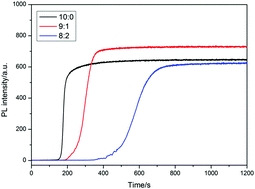Fabrication of a superhydrophobic surface by modulating the morphology of organogels†
Abstract
A low-molecular weight organic gelator (LMOG) bearing a hydrazine linkage and end-capped by alkoxy-substituted phenyl, namely 1,4-bis[(3,4-bisoctyloxyphenyl)hydrozide]phenylene (BPH-8), was used to facilely fabricate superhydrophobic surfaces by the drop-casting method. High quality superhydrophobic surfaces could be successfully prepared in one step in a mixed solvent of ethanol and tetrahydrofuran. The wettability of the surfaces can be modulated from superhydrophobicity to hydrophobicity through changing the ethanol and tetrahydrofuran ratio of the mixed solvent. SEM and AFM images demonstrated that the morphologies changed from hierarchical micro/nano structures to porous structures with increasing content of tetrahydrofuran. This might be the main reason for the wettability change. It was confirmed that these molecules self-assemble into a lamellar structure and show priority growth in one dimension to form nano-scaled fibers. This work not only demonstrated the superiority of superhydrophobic surface preparation through molecular self-assembly, but also offered an easy way to extend its application in the field of surface science.



 Please wait while we load your content...
Please wait while we load your content...